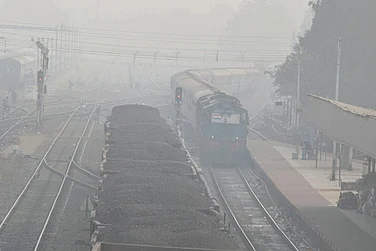“For greater clearness, they took, as their mnemonic base, their own house, where they were living, attaching to each one of its parts a distinct event- and the courtyard, the garden, the surroundings, the entire district, had no other meaning than to jog their memory.”
— Home Territories
It was a rainy evening in Delhi and the area of Bhogal, Jangpura Extension was lit with Afghans sitting on the porch enjoying the weather. As I walked down the lane, I could see some men wearing pathani suits getting ready for iftar — evening meal in Ramzan to break the fast.
I was searching for Sania’s house (name changed) on those intricately tiled footpaths and it started raining like cats and dogs. When I finally reached the building, I entered a cubby hole with a lot of staircases which felt like an adventurous hike. In a long hallway, there was a door. I rang the doorbell and heard a baby scream “Maadar” (Mother). I saw a woman in a long robe asking me what I wanted through the steel bars of the door. I asked for Sania and discovered that she lives on the floor above, referring to her home as “Hema Malini's house” — apparently Sania’s mother was known as Hema Malini in the building. This made me more curious to meet her.
As I reached there, a beautiful lady with brown hair and deep eyes opened the door and welcomed me with a warm hug. I could not comprehend what she was saying because she could not speak much Urdu or Hindi. She spoke only Pashto. Sania was sitting with her father when her mother started telling me her stories of agony and Sania was translating for me.
Ameena (name changed) still remembers the day when they left Afghanistan. Her family is a first-generation migrant. In January 2012, they arrived in New Delhi after facing many death threats from the Taliban. Ghulam Najib (name changed) was working as a policeman in Afghanistan and was a key person to help the department in arresting a Talibani. Sania was 17 and was occupied with her class 12 exams when she was told that they had to leave Afghanistan. They could not wait to collect her certificates from school and that has affected her education massively.
Najeeb said, “It was very important for me to keep all of us alive, rather than searching for school certificates.”
Najeeb had left his mother with his siblings in Afghanistan. The uncertainty and anxiety that would have crippled all of them is so chilling to imagine. The decision to leave Afghanistan had been spiralling in their minds for one month because of many instances like the attack on their car twice. They had kept many places as options for fleeing but landed in India because of fast visa processes. The stress accompanied by the decision of leaving and settling in a new place like refugees makes one question the very construct of home. Ideas of mobility and home are crucial factors in shaping young minds and their perspectives, though I am not trying to question local sense of belonging but how all of this can influence homemaking practices of these refugees definitely needs to be examined.
“Before the Taliban took over, they were attempting to control and attack smaller provinces, and people began to believe they would take over Kabul,” Sania explained.
Sania’s brother came to India first to search for a place to live and, after 15 days, all of them migrated. Since they had left home in a very haywire situation, much of their important documents were left behind. Sania could not continue with her education. She started working in a small dental clinic very early in her life because she felt very suffocated at home.
She said, “Of course, leaving home is sad. In fact, I used to cry every day because my sisters still live there and I have not seen them in many years. We used to roam around in Kabul wearing western dresses before Taliban. We have accepted our fate as it is now.”
Sania also said that India is safer than any of its neighbours where livelihood is compromised and that the people of India have always welcomed them. As Ameena aunty started telling me what ails her tender heart, with tears in her eyes, I could only imagine what Afghan families who live as refugees in India have gone through over years.
While talking, we could hear azaan from the window and Ameena whispered “Alhamdulillah, it’s time for iftar”. She began to lay down the dastarkhwan —the tablecloth on which the food is laid out on— and I had the privilege to share my iftar with them, cherishing fresh fruits and her handmade pakoras. Najeeb raised his hands in prayer, asking God for forgiveness and to bless his nest while nostalgically stating: “You know I have been sitting inside the house from 12 years with no socialising. I have no friends here. In Kabul, I used to wander with my friends every day. I also fear the day that my kids will be getting married and nobody will be here with us.”
Najeeb has sold all of his belongings in Afghanistan to keep his family safe here. But besides all, there are still some legal issues which haunt them on a daily basis.
The United Nations High Commissioner for Refugees (UNHCR) categorises refugees and asylum-seekers who need protection, shelter, health, and education as persons of concern. There are 43,157 persons that are “of concern” to the UN refugee agency in India, out of which 15,559 refugees and asylum-seekers are from Afghanistan. India does not have a codified law for refugees because of India’s unwillingness to accede to the 1951 UN Refugee Convention as well as the country’s weakness in establishing any domestic refugee legislation. As a result, the Afghan refugees have suffered from a precarious legal status and have not been accorded the formal right to work or establish businesses in India. Neither have the Indian authorities encouraged Afghans to integrate or become naturalised citizens, although a significant proportion of them —currently around 65 per cent— are Hindus and Sikhs with historical links to the country where they have sought asylum.
Afghans have been using refugee cards, which only function by renewing visas every six months to one year, for banking, rationing, and other purposes, but now that everything is regulated by the Adhaar card, Afghans believe their inclusivity is jeopardised. Refugee cards—or blue paper— which is temporary in nature is meaningless to them because it does not obtain them a rental housing, a valid SIM card, or a bank account.
Sania said, “There is not much awareness among the people or authorities regarding refugee cards and people frequently say ‘what is this?’ and ‘please show us your Aadhaar card.”
Afghans feel very insecure because of their sensitive identities. The state must ensure that Afghan refugees who arrive in Delhi are well integrated into society. People must be educated about refugees and their legal rights so that they do not encounter prejudice based on their ethnicity. Concerning the future of UNHCR’s Afghan refugee programme in New Delhi, the organisation should continue to monitor Afghan refugees’ welfare in the city, taking into account their legal, physical, material, and psychological security.
(Tehmeena Rizvi is a Research Associate with Policy Perspectives Foundation and is pursuing PhD from Bennett University. Her areas of work include gender, inclusion, conflict, and development.)























